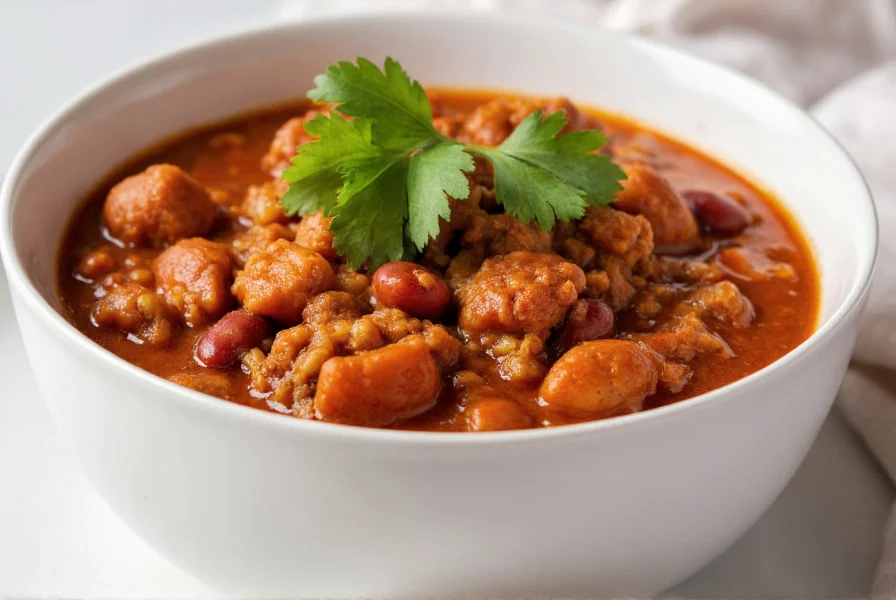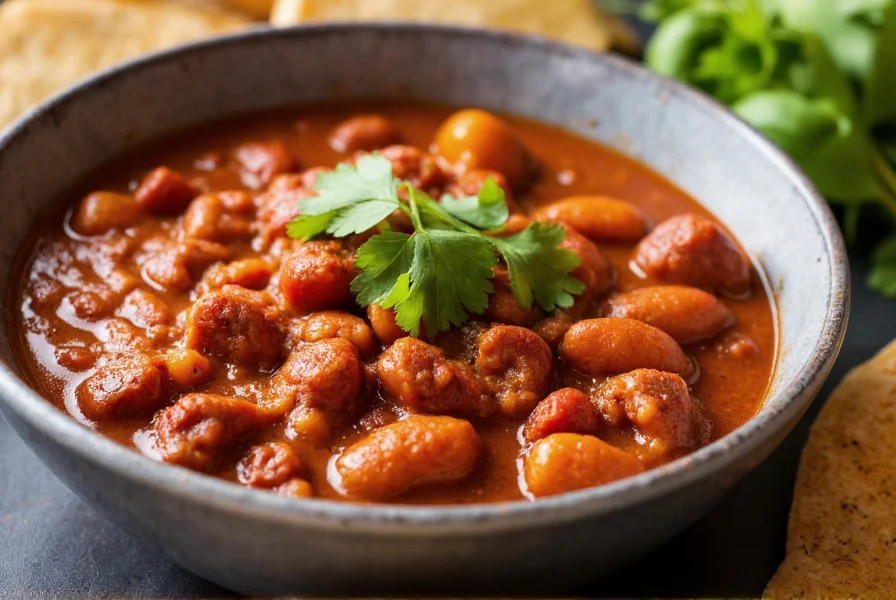Creating a truly high protein chili requires strategic ingredient selection and preparation techniques that maximize protein content while preserving the complex flavors chili lovers expect. Unlike traditional recipes that average 15-20g of protein per serving, optimized high protein versions nearly double this amount through smart substitutions and additions that don't compromise on taste or texture.
The Science Behind Protein-Packed Chili
Protein requirements vary based on activity level and health goals, but most adults need 0.8-2.2 grams of protein per kilogram of body weight daily. For active individuals or those building muscle, high protein chili serves as an ideal meal that delivers substantial protein in a satisfying, flavorful format. The combination of complete and incomplete proteins in well-designed chili recipes creates a balanced amino acid profile that supports muscle synthesis and recovery.
Key Protein Boosters for Maximum Nutrition
Transforming standard chili into a high-protein powerhouse involves incorporating these protein-rich ingredients:
- Extra-lean ground turkey or chicken (99% lean provides 26g protein per 4oz)
- Textured vegetable protein (TVP) - absorbs flavors while adding 12g protein per ¼ cup dry
- Black beans and kidney beans - 15g protein per 2-cup serving when combined
- Quinoa - adds complete protein and thickens chili naturally
- Unsweetened pea protein powder - dissolves invisibly while adding 20g protein per serving
| Protein Source | Protein per Serving | Flavor Impact | Best For |
|---|---|---|---|
| Extra-lean ground turkey | 26g per 4oz | Mild, takes on spice well | All chili varieties |
| Textured vegetable protein | 12g per ¼ cup dry | Neutral, absorbs flavors | Vegan/vegetarian chili |
| Black beans & kidney beans | 15g per 2 cups | Earthy, traditional chili taste | All chili varieties |
| Pea protein powder | 20g per 2 scoops | Virtually undetectable | Maximizing protein discreetly |
Perfect High Protein Chili Recipe (42g Protein Per Serving)
This tested recipe delivers exceptional flavor while providing substantial protein. Preparation time: 15 minutes. Cooking time: 45 minutes. Serves: 6.

Ingredients
- 1.5 lbs 99% lean ground turkey
- 2 cups cooked black beans (low sodium)
- 2 cups cooked kidney beans (low sodium)
- 1 cup textured vegetable protein (rehydrated)
- 1.5 cups cooked quinoa
- 28 oz crushed tomatoes (no salt added)
- 15 oz tomato sauce (no salt added)
- 1 large onion, diced
- 1 bell pepper, diced
- 4 cloves garlic, minced
- 3 tbsp chili powder
- 2 tsp cumin
- 1.5 tsp smoked paprika
- 1 tsp cayenne pepper (optional)
- 2 scoops unflavored pea protein powder
- Salt and pepper to taste
Preparation Method
- Brown ground turkey in large pot over medium heat, breaking into small pieces
- Add onions, bell peppers, and garlic; sauté until vegetables soften (5-7 minutes)
- Stir in chili powder, cumin, smoked paprika, and cayenne; cook 1 minute to toast spices
- Add crushed tomatoes, tomato sauce, black beans, kidney beans, TVP, and quinoa
- Bring to simmer, then reduce heat and cook uncovered for 30 minutes, stirring occasionally
- Remove from heat, stir in pea protein powder until fully incorporated
- Let rest 10 minutes before serving to allow flavors to meld and protein powder to fully absorb
Meal Prep and Storage Tips
High protein chili excels as a meal prep option. Store portions in airtight containers for up to 5 days in the refrigerator or freeze for up to 3 months. The flavors actually improve after 24 hours as ingredients continue to meld. For optimal protein retention and texture, avoid overcooking beans and add protein powder only after removing from heat.
When reheating, add a splash of broth or water to restore ideal consistency. For post-workout nutrition timing, consume within 45 minutes of exercise to maximize muscle recovery benefits. This high protein chili recipe provides the ideal 3:1 carbohydrate-to-protein ratio recommended for optimal recovery.
Common High Protein Chili Mistakes to Avoid
Many home cooks make these critical errors when attempting high protein chili:
- Overloading with protein powder - exceeding 2 scoops can create chalky texture and digestive discomfort
- Using regular ground beef - 80% lean beef contains too much fat that separates during cooking
- Skipping the resting period - protein powder needs time to fully hydrate for best texture
- Adding beans straight from can - rinsing removes excess sodium and starch that affects texture
- Overcooking vegetables - bell peppers and onions should retain some texture for flavor balance
Variations for Different Dietary Needs
This adaptable high protein chili framework works for various dietary preferences:
- Vegan high protein chili - replace turkey with extra TVP and add 1 cup cooked lentils
- Keto high protein chili - reduce beans to ½ cup total and add 1 cup diced mushrooms
- Spicy protein chili for athletes - add chipotle peppers in adobo sauce and extra protein powder
- Quick high protein chili - use pre-cooked beans and instant quinoa to reduce prep time

Nutritional Benefits Beyond Protein
While protein content gets the spotlight, high protein chili delivers comprehensive nutrition. The combination of lean protein, complex carbohydrates from beans and quinoa, and healthy fats creates sustained energy release. Fiber content (12-15g per serving) supports digestive health and enhances satiety. The lycopene from tomatoes provides antioxidant benefits, while spices like cumin and chili powder offer anti-inflammatory properties.
For those managing blood sugar, this high protein chili recipe has a low glycemic index due to its balanced macronutrient profile. The substantial protein and fiber content slows glucose absorption, making it an excellent choice for metabolic health. Registered dietitians often recommend this type of high protein chili for clients seeking sustainable weight management solutions that don't leave them feeling deprived.
Frequently Asked Questions
How can I increase protein in chili without meat?
Combine multiple plant proteins: use textured vegetable protein (TVP), black beans, kidney beans, quinoa, and 1-2 scoops of pea protein powder. This creates a complete amino acid profile while delivering 30+ grams of protein per serving without any meat.
Does adding protein powder change the taste of chili?
Unflavored pea protein powder dissolves completely without altering taste when added after cooking. Use no more than 2 scoops per batch to avoid chalkiness. The robust spices in chili effectively mask any subtle flavor from quality protein powders.
How much protein should chili have to be considered 'high protein'?
True high protein chili contains at least 25 grams of protein per standard serving. Most traditional chili recipes provide 15-20g protein, while optimized high protein versions deliver 30-45g per serving, making them suitable as complete meal replacements for active individuals.
Can I make high protein chili in a slow cooker?
Yes, but add protein powder only during the last 15 minutes of cooking. Brown meat and sauté vegetables first, then cook on low for 6-8 hours. Stir in protein powder, cover, and let sit for 15 minutes before serving to maintain optimal texture and protein integrity.











 浙公网安备
33010002000092号
浙公网安备
33010002000092号 浙B2-20120091-4
浙B2-20120091-4